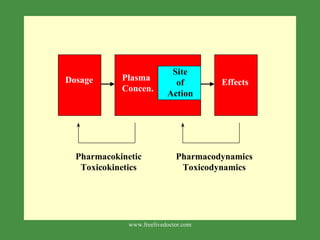
Toxicokinetics
- 2. DISPOSITION OF CHEMICALS The disposition of chemicals entering the body (from C.D. Klaassen, Casarett and Doull’s Toxicology , 5th ed., New York: McGraw-Hill, 1996). www.freelivedoctor.com
- 3. Plasma Concentration Time Plasma concentration vs. time profile of a single dose of a chemical ingested orally www.freelivedoctor.com
- 5. Bound Free Free Bound LOCUS OF ACTION “ RECEPTORS ” TISSUE RESERVOIRS SYSTEMIC CIRCULATION Free Drug Bound Drug ABSORPTION EXCRETION BIOTRANSFORMATION www.freelivedoctor.com
- 11. Absorption of Aerosols and Particles : 1- Particle Size 2- Water solubility of the chemical present in the aerosol or particle REMOVAL OF PARTICLES Physical Phagocytosis Lymph Absorption from the Lungs www.freelivedoctor.com
- 12. NasopharyngealRegion 5-30 µm Trachea Bronchi Bronchioles 1-5 µm Alveolar Region 1 µm DEPOSITION OF PARTICLES IN THE RESPIRATORY SYSTEM www.freelivedoctor.com
- 15. Bioavailability Definition: the fraction of the administered dose reaching the systemic circulation for i.v.: 100% for non i.v.: ranges from 0 to 100% e.g. lidocaine bioavailability 35% due to destruction in gastric acid and liver metabolism First Pass Effect www.freelivedoctor.com
- 16. Bioavailability Dose Destroyed in gut Not absorbed Destroyed by gut wall Destroyed by liver to systemic circulation www.freelivedoctor.com
- 17. Plasma concentration Time (hours) i.v. route oral route Bioavailability (AUC) o (AUC) iv www.freelivedoctor.com
- 18. Principle For chemicals taken by routes other than the i.v. route, the extent of absorption and the bioavailability must be understood in order to determine whether a certain exposure dose will induce toxic effects or not. It will also explain why the same dose may cause toxicity by one route but not the other . www.freelivedoctor.com
- 23. 100-fold increase in free pharmacologically active concentration at site of action. NON-TOXIC TOXIC Alter plasma binding of chemicals 1000 molecules % bound molecules free 99.9 90.0 100 1 www.freelivedoctor.com
- 24. Chemicals appear to distribute in the body as if it were a single compartment. The magnitude of the chemical’s distribution is given by the apparent volume of distribution (Vd). Amount of drug in body Concentration in Plasma Vd = PRINCIPLE www.freelivedoctor.com
- 25. Volume of Distribution Volume into which a drug appears to distribute with a concentration equal to its plasma concentration www.freelivedoctor.com
- 27. Examples of apparent Vd’s for some drugs www.freelivedoctor.com Drug L/Kg L/70 kg Sulfisoxazole 0.16 11.2 Phenytoin 0.63 44.1 Phenobarbital 0.55 38.5 Diazepam 2.4 168 Digoxin 7 490
- 30. Nephron Structure The structure of the nephron (from A.C. Guyton, Textbook of Medical Physiology , Philadelphia, W.B. Saunders Co.; 1991 www.freelivedoctor.com
- 32. The enterohepatic shunt Portal circulation Liver gall bladder Gut Bile duct Drug Biotransformation; glucuronide produced Bile formation Hydrolysis by beta glucuronidase www.freelivedoctor.com
- 34. CLINICAL TOXICOKINETICS Quantitative Aspects of Toxicokinetics www.freelivedoctor.com
- 36. Plasma concentration Influence of Variations in Relative Rates of Absorption and Elimination on Plasma Concentration of an Orally Administered Chemical www.freelivedoctor.com
- 39. First Order Elimination Plasma concentration Ct = Co e -Kel.t lnCt = lnCo – Kel .t logCt = logCo - Kel . t 2.303 dC/dt = k y = b – a.x www.freelivedoctor.com
- 41. Time Plasma Concentration 0 1 2 3 4 5 6 1 10 100 1000 10000 Zero Order Elimination logCt = logCo - Kel . t 2.303 www.freelivedoctor.com
- 42. Plasma Concentration Profile after a Single I.V. Injection www.freelivedoctor.com
- 43. lnCt = lnCo – Kel.t When t = 0, C = C 0 , i.e., the concentration at time zero when distribution is complete and elimination has not started yet. Use this value and the dose to calculate Vd. Vd = Dose/C 0 www.freelivedoctor.com
- 44. lnCt = lnCo – Kel.t When Ct = ½ C 0 , then Kel.t = 0.693. This is the time for the plasma concentration to reach half the original, i.e., the half-life of elimination. t1/2 = 0.693/Kel www.freelivedoctor.com
- 47. Rate of elimination = Kel x Amount in body Rate of elimination = CL x Plasma Concentration Therefore, Kel x Amount = CL x Concentration Kel = CL/Vd 0.693/t1/2 = CL/Vd t1/2 = 0.693 x Vd/CL www.freelivedoctor.com
- 51. Time plasma conc Cumulation Toxic level Single dose www.freelivedoctor.com
- 52. Concentration due to a single dose Concentration due to repeated doses The time to reach steady state is ~4 t1/2’s www.freelivedoctor.com
- 54. But Conc. x dt = small area under the curve. For total amount eliminated (which is total given or the dose if i.v.), add all the small areas = AUC. Dose = CL x AUC and Dose x F = CL x AUC dX/dt = CL x Conc. dX = CL x Conc. x dt www.freelivedoctor.com
- 55. Plasma concentration Time (hours) Bioavailability (AUC) o (AUC) iv = i.v. route oral route www.freelivedoctor.com
- 56. Variability in Pharmacokinetics Daily Dose (mg/kg) Plasma Drug Concentration (mg/L) 0 5 10 15 0 10 20 30 40 50 60 www.freelivedoctor.com
- 59. THE DOSE-RESPONSE RELATIONSHIP The dose-response relationship (from C.D. Klaassen, Casarett and Doull’s Toxicology , 5th ed., New York: McGraw-Hill, 1996). www.freelivedoctor.com